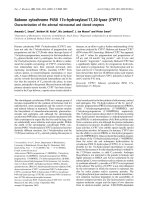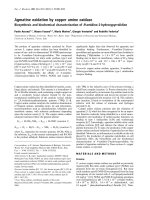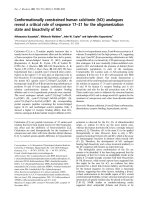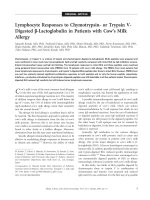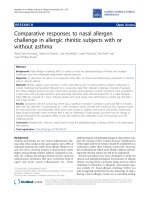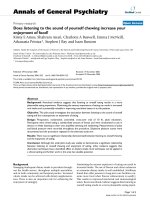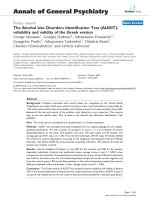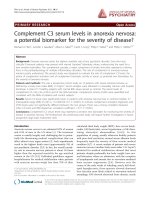Báo cáo y học: "Pooled indices to measure rheumatoid arthritis activity: a good reflection of the physician’s mind" pdf
Bạn đang xem bản rút gọn của tài liệu. Xem và tải ngay bản đầy đủ của tài liệu tại đây (78.34 KB, 3 trang )
Page 1 of 3
(page number not for citation purposes)
ACR = American College of Rheumatologists; CDAI = Clinical Disease Activity Index; DAS = Disease Activity Score; DAS28 = Disease Activity
Score based on 28-joint evaluation; RA = rheumatoid arthritis; ROC = receiver operating characteristic; SDAI = Simplified Disease Activity Index.
Available online />Abstract
Several pooled indices for the assessment of rheumatoid arthritis
disease activity are available to rheumatologists. Face and criterion
validity of these instruments can be assessed by determining the
association of their measurements with opinions of physicians.
Several confounding aspects must be considered in such analyses,
especially blinding of the person(s) making the decisions to the
instruments being studied and to the objective of the study in
general. From several studies in the literature, there is currently no
evidence that any one of the available composite indices is better or
worse than any other. The choice of index in clinical practice should
ideally be based on practical considerations related to the needs of
the rheumatologist in the respective health care setting.
Several pooled indices are available to measure rheumatoid
arthritis (RA) activity on a continuous scale [1]. These include
the Disease Activity Score (DAS), the DAS based on 28 joint
counts (DAS28), the Simplified Disease Activity Index (SDAI),
and the Clinical Disease Activity Index (CDAI). These indices
are essentially based on the same attributes of RA: joint
counts, the patient’s evaluation of RA activity, and acute-
phase reactants. The SDAI and CDAI also include the
physician’s assessment of RA activity, and do not require
transformation or weighting of the individual components or
the use of a calculator. In addition, the CDAI is the only index
that does not include a measure of acute-phase response. All
of these individual variables that are pooled in the various
indices have face validity in the context of measuring RA
activity. In other words, each variable, if available, is likely to
be considered in the implicit clinical assessment of RA
activity by the clinician. When measures are integrated to
yield pooled indices, the question slightly shifts toward how
much the composite number produced by the index relates to
a clinician’s intuitive integration of the available measures of
disease activity. In other words, is the obtained number
higher in those patients who physicians consider to have
more active disease, and is it lower in those considered to
have less active disease?
In a recent issue of Arthritis Research & Therapy, Vander
Cruyssen and colleagues [2] aimed to compare this aspect of
validity for the various disease activity indices. The results
from their study suggest that the DAS28 is the best
determinant of physician opinion, based on each physician’s
decision to increase or not increase the dose of infliximab in
patients with RA in a real life setting. This method is very
typical and was used in the past, for example, to derive the
original DAS and the DAS28 [3,4].
Several issues need consideration when analyses are based
on physician opinion, and many of these issues are difficult to
implement in a study setting. First, ideally physicians should
not be aware that their clinical decision is part of the
investigation. This issue can be regarded as an analogy to the
classical epidemiologic problem of ‘bias by observation’: the
fact that physicians are aware that their behavior is being
observed is likely to make them more cautious and more
considerate in their decisions as compared with their usual
‘protected’ clinical environment. Second, the physician’s
decision – as the ‘gold standard’ – should not be influenced
by variables and measures that are planned to be used as
independent predictors of this gold standard decision in
subsequent statistical analyses. For example, one would
expect that even a relatively unimportant measure would have
a greater association with the clinician’s decisions if it was
the only measure available to that physician, and was thus the
only measure objectively informing the decision.
Commentary
Pooled indices to measure rheumatoid arthritis activity:
a good reflection of the physician’s mind?
Daniel Aletaha
National Institutes of Arthritis, Musculoskeletal, and Skin Diseases, National Institutes of Health, Bethesda, Maryland, USA
Corresponding author: Daniel Aletaha,
Published: 14 December 2005 Arthritis Research & Therapy 2006, 8:102 (doi:10.1186/ar1870)
This article is online at />© 2005 BioMed Central Ltd
See related research by Vander Cruyssen et al. in issue 7.5 [ />Page 2 of 3
(page number not for citation purposes)
Arthritis Research & Therapy Vol 8 No 1 Aletaha
In the study conducted by Vander Cruyssen and coworkers
[2], this second issue is a potential concern. From the report
it is unclear what was the basis for the treating rheuma-
tologists’ decision to increase the infliximab dose. The authors
indicated that the composite scores ‘were calculated after
data collection so that the treating rheumatologist was
unaware of the exact values of those composite scores’.
However, in a previous report on this cohort [5], the authors
stated that ‘the ACR [American College of Rheumatology]
response criteria and the DAS28 score were evaluated at the
same time points before the infliximab infusion’. This
statement indicates that calculation of the DAS28 was
required per study protocol, and that this preceded the
decision regarding whether or not to increase the dose of
infliximab. Because other variants of the DAS28, SDAI, or
CDAI were not calculated during the study, this can
potentially magnify the ability of the DAS28 to predict a
physician’s decision in comparison with these other indices.
On the other hand, if the physicians were blinded to the
evaluation of ACR response and the DAS28, then it is
unclear why the authors emphasized that this was done
‘before the infliximab infusion’. Importantly, however, the
authors revealed a high correlation coefficient among all
investigated indices (r = 0.9 or higher) and mentioned that ‘all
those alternative scores perform similarly or slightly worse than
the original DAS28’, which is surprisingly good performance if
only the DAS28 was calculated during the study.
Another issue was emphasized in the commentary by van Riel
and Fransen [6]; more than 50% of patients in whom the
infliximab dose was not increased had a DAS28 score above
3.2, which indicates moderate or high disease activity. This
could mean that the treating rheumatologists either neglected
to treat patients with significant disease activity more
aggressively or that there is an inconsistency between the
clinical characteristics of the patients and the DAS28 score.
This issue of potentially poor sensitivity of the DAS28 criteria
in identifying patients with moderate disease activity is not
discussed in the report by Vander Cruyssen and coworkers.
In fact, it supplements findings that the weighting of variables
in the DAS28 may misrepresent the actual disease activity,
especially in the lower disease activity ranges, because it
weights erythrocyte sedimentation rate and tender joint counts
quite strongly [7,8]. Taken together these issues would
reduce the ‘face validity’ of the construction of the index.
We recently conducted a study to derive cutoff values for the
DAS28 and the SDAI [7]. This study was based on the
ratings of 35 expert rheumatologists. We re-analyzed these
data to correlate SDAI and DAS28 scores of 32 paper
patients (i.e. disease activity profiles of real RA patients) with
the gold standard of physician’s judgment, and performed a
receiver operating characteristic (ROC) analysis (Fig. 1). The
gold standard for this analysis was the physicians’ judgment
of moderate or high disease activity. We found that the
(untransformed) SDAI exhibited an area under the ROC curve
of 0.96 (95% confidence interval 0.95–0.97); the DAS28
was similar, at 0.95 (95% confidence interval 0.94–0.96).
The sensitivity at 95% specificity (as analyzed in the study by
Vander Cruyssen and coworkers) was 80.5% for the SDAI
and 76.2% for the DAS28. Likewise, a study conducted by
Soubrier and coworkers [9] found an area under the ROC
curve of 0.91 for the SDAI and of 0.86 for the DAS28, using
a rheumatologist’s decision to start a new disease-modifying
antirheumatic drug as the gold standard.
Taking together the data from the study by Vander Cruyssen
and coworkers [2] and others, we conclude that the DAS28
and SDAI exhibit similar face validity/criterion validity, with the
potential exception of the very low disease activity ranges
[6,7]. Arguments on validity that are based on minimal
differences can be confusing for the rheumatologic
community, especially when these differences show opposite
directions in different studies. At the current time, there is no
evidence that one index is better or worse than another.
The SDAI and the CDAI were not developed to oppose the
DAS or DAS28 but to provide rheumatologists with a simple
tool that can be calculated on the spot (CDAI) and without the
need for a calculator (SDAI and CDAI). The fact that all of these
scores have similar validity increases the choice of instruments
available to physicians, allowing them to pick the index that best
fits their practical needs and their environmental setting.
Figure 1
Performance of the SDAI and the DAS28. Receiver operating
characteristic curve analysis of the performance of the SDAI and the
DAS28, using expert opinion on patient profiles as the gold standard.
The experts rated whether moderate or high disease activity was
present or not. DAS28, Disease Activity Score based on 28-joint
evaluation; SDAI, Simplified Disease Activity Index.
Page 3 of 3
(page number not for citation purposes)
Competing interests
The author(s) declare that they have no competing interests.
References
1. Aletaha D, Smolen JS: The definition and measurement of
disease modification in inflammatory rheumatic diseases.
Rheum Dis Clin N Am 2005:in press.
2. Vander Cruyssen B, Van Looy S, Wyns B, Westhovens R, Durez
P, Van den Bosch F, Veys EM, Mielants H, De Clerck L, Peretz A,
et al.: DAS28 best reflects the physician’s clinical judgment of
response to infliximab therapy in rheumatoid arthritis
patients: validation of the DAS28 score in patients under
infliximab treatment. Arthritis Res Ther 2005, 7:R1063-R1071.
3. van der Heijde DM, van ‘t Hof MA, van Riel PL, Theunisse LA, Lub-
berts EW, van Leeuwen MA, van Rijswijk MH, van de Putte LB:
Judging disease activity in clinical practice in rheumatoid
arthritis: first step in the development of a disease activity
score. Ann Rheum Dis 1990, 49:916-920.
4. Prevoo ML, van ‘t Hof MA, Kuper HH, van Leeuwen MA, van de
Putte LB, van Riel PL: Modified disease activity scores that
include twenty-eight-joint counts. Development and validation
in a prospective longitudinal study of patients with rheuma-
toid arthritis. Arthritis Rheum 1995, 38:44-48.
5. Durez P, Van den Bosch F, Corluy L, Veys EM, De Clerck L,
Peretz A, Malaise M, Devogelaer JP, Vastesaeger N, Geldhof A, et
al.: A dose adjustment in patients with rheumatoid arthritis
not optimally responding to a standard dose of infliximab of 3
mg/kg every 8 weeks can be effective: a Belgian prospective
study. Rheumatology (Oxford) 2005, 44:465-468.
6. Van Riel PC, Fransen J: DAS28: a useful instrument to monitor
infliximab treatment in patients with rheumatoid arthritis.
Arthritis Res Ther 2005, 7:189-190.
7. Aletaha D, Ward MM, Machold KP, Nell VP, Stamm T, Smolen JS:
Remission and active disease in rheumatoid arthritis: defining
criteria for disease activity states. Arthritis Rheum 2005, 52:
2625-2636.
8. Makinen H, Kautiainen H, Hannonen P, Sokka T: Is DAS28 an
appropriate tool to assess remission in rheumatoid arthritis?
Ann Rheum Dis 2005, 64:1410-1413.
9. Soubrier M, Zerkak D, Dougados M: Should we revisit the defin-
ition of higher disease activity state in rheumatoid arthritis
(RA)? [Abstract.] Arthritis Rheum 2004, 50:S387.
Available online />
